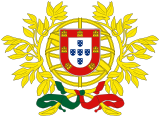
Back Organización territorial de Portugal AST Verwoitungsgliedarung vo Portugal BAR Адміністрацыйны падзел Партугаліі Byelorussian Administrativna podjela Portugala BS Organització territorial de Portugal Catalan Administrativní dělení Portugalska Czech Verwaltungsgliederung Portugals German Administra divido de Portugalio Esperanto Organización territorial de Portugal Spanish Portugalgo lurralde antolaketa Basque
 |
|---|
| Constitution |

Portugal is a unitary state with delegated authority to three levels of local government that cover the entire country:
- 2 autonomous regions (Azores and Madeira), and in Continental Portugal: 2 metropolitan areas, and 21 intermunicipal communities
- 308 municipalities
- 3091 civil parishes (freguesias) (except Corvo Island which only has a single municipality)
The Judiciary of Portugal has a separate geographic system.
The government structure is based on the 1976 Constitution, adopted after the 1974 Carnation Revolution.[1]
The powers of the 18 Districts were removed when the government decided not to reappoint their Civil Governors in 2011.
The legal status of a city or town is granted only for ceremonial purposes, typically with smaller boundaries than municipalities. Some municipalities have several cities.
Starting in 2003, Eurostat has defined regions and subregions in the Nomenclature of Territorial Units for Statistics (NUTS) standard. These are coincide with some local government borders, but are otherwise only used for statistical purposes.
- ^ "7th Constitutional Revision" (PDF). Assembly of the Republic (Portugal). Archived from the original (PDF) on 22 October 2014. Retrieved 13 August 2014. - Articles 225-262